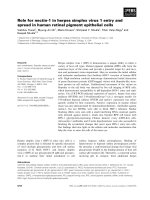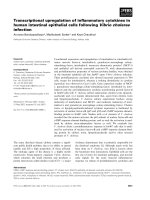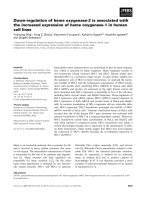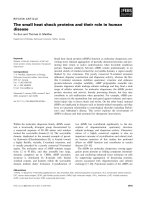SCARAB BEETLES IN HUMAN CULTURE
Bạn đang xem bản rút gọn của tài liệu. Xem và tải ngay bản đầy đủ của tài liệu tại đây (944.18 KB, 18 trang )
Museum, University of Nebraska State
Papers in Entomology
University of Nebraska - Lincoln Year
SCARAB BEETLES IN HUMAN
CULTURE
Brett C. Ratcliffe
University of Nebraska-Lincoln, bratcliff
This paper is posted at DigitalCommons@University of Nebraska - Lincoln.
/>S
CARAB
B
EETLES IN
H
UMAN
C
ULTURE
B
RETT
C. R
ATCLIFFE
Systematics Research Collections
W-436 Nebraska Hall
University of Nebraska
Lincoln, NE 68588-0514, U.S.A.
Abstract
The use of scarab beetles (Coleoptera: Scarabaeidae) by primarily pre- and non-industrial
peoples throughout the world is reviewed. These uses consist of (1) religion and folklore, (2)
folk medicine, (3) food, and (4) regalia and body ornamentation. The use of scarabs in
religion or cosmology, once widespread in ancient Egypt, exists only rarely today in other
cultures. Scarabs have a minor role in folk medicine today although they may have been
more important in the past. The predominant utilization of these beetles today, and
probably in the past as well, is as food with emphasis on the larval stage. Lastly, particularly
large or brightly colored scarabs (or their parts) are used (mostly in the New World) to
adorn the body or as regalia.
If one advances confidently in the direction of his dreams and endeavors to live the
life which he has imagined, he will meet with a success unexpected
in the common hours.—Thoreau
This paper is warmly dedicated to Henry Howden in celebration of his many
long years of dedicated field work in the Neotropics and the many fine paperson
scarab systematics that flowed from his exploration and research. Henry’s
illustrious career has added immeasurably to our knowledge of all things
scarabaeoid. His students and colleagues have all benefited from his mentoring,
advice, and wealth of knowledge. For many decades, he has been considered Mr.
Scarab to the world community. I am proud to have him as a friend and colleague
and to have had my career materially influenced by his example.
The following review illustrates the various ways in which scarab beetles are
(were) perceived or used by pre- or non-industrial peoples throughout the world.
Ruddle (1973) noted that the scientific literature dealing with the use of insects in
pre-industrial societies is both scattered and sparse and is generally of a cursory
nature. The nonfood uses of insects are not usually mentioned, and this may
result from the strong, culturally conditioned repugnance with which many non-
entomologist researchers perceive insects. Ruddle concluded that many of these
researchers regarded entomophagy as either a curiosity or a relict of barbarism,
and this may, unfortunately, have persuaded indigenous populations to withhold
information from investigators. I have excluded from this discussion the use of
scarabs by modern, technological societies because this usually consistsof
agricultural or artistic applications. Scarabs, for example, are often used in
modern cultures for art (painting, sculpture, baskets, wood, and lacquer ware).
Similarly, extensive use is made of scarabs as toys (plastic primarily) andas
‘‘entertainment’’ in the form of betting on fights between adults of horned
rhinoceros beetles such as Xylotrupes gideon (L.) (Dynastinae) in Malaysia and
Coleopterists Society Monograph Number 5:85–101. 2006.
85
the Philippines. These kinds of uses are too numerous and varied for this
particular treatment. Below I discuss the use of scarabs on each continent. Some
of the uses are historical, while other parts reflect modern utilization of scarab
beetles.
Africa
The Egyptian Sacred Scarab
The first documented use of scarab beetles by humankind was a small alabaster
case in the shape of a scarab (dung beetle) by the ancient Egyptians in the early
first dynasty (ca. 3,000 B.C.) (Cambefort 1994). The behavior and nest-building
activities of some dung beetles were such that the Egyptians established a complex
symbolism for them as far back as 2,700 B.C. (Crowson 1981; Cambefort 1994).
Historically, dung beetles of the genera Kheper, Scarabaeus, Gymopleurus,
Copris, and Catharsius (all Scarabaeinae) played an important and prominent role
in the mythology of ancient Egypt. Cambefort (1994) suggested the first scarab
symbol was the metallic Kheper aegyptiorum (Latreille). Collectively known as the
sacred scarab, these insects and their ball-rolling behavior (at least in the first
three genera listed above; Copris and Catharsius are not ball rollers) symbolized
certain parts of the Egyptian polytheistic theory of the universe. Ra, according to
Egyptian theology, was the Sun God responsible for the daily shepherding of the
sun across the sky. Ra, in this belief system, was also the first ruler of Egypt. A
cult developed whereby Ra was symbolized by the scarab, and the sun was
represented by the dung ball. The scarab pushing its ball was an earthly
manifestation of Ra escorting the sun on its daily journey across the sky (Fig. 1).
The setting of the sun was also presumably correlated with burial of the dung ball
in the earth by the scarab.
According to Klausnitzer (1981), scarab reproductions are known from Egypt
as early as the third millennium B.C., and an ‘‘embalmed’’ scarab was found
belonging to the later period of the New Empire (700–33 B.C.). Hieroglyphics
show a scarab representing creative power, and this glyph is interpreted as
a symbol of Khepri, the God of Creation. The scarab also represented the
abstract concept ‘‘cheper’’ which meant ‘‘to become,’’ ‘‘to come into being,’’ or
‘‘that which has come into being.’’
After 200 B.C., during the Middle Kingdom, older interpretations of the role of
scarabs changed so that the beetle was credited with the supernatural powers of
insuring rebirth after death. This developed, in part, from the belief that all dung
beetles were male, and that they could procreate their own young. Thus, the Sun
God, Ra, did not originate from the joining of two beings of opposite sex but was
instead born out of primary matter. An incomplete knowledge of the beetle’s life
cycle contributed to its mystique.
Observing a scarab emerging from a corpse-like mummy (the pupa) was likened
to rebirth. Cambefort (1994) suggested that Egyptian priests thought that
whatever happened to the sun under ground (after it set) was essentially the same
as scarab metamorphosis. The sun entered the ground at the end of the day as did
the scarab and ‘‘his’’ ball of dung. The sun then traveled underground from west
to east while undergoing a metamorphosis, or kheprus, that resulted in
regeneration the following morning when the sun rose again from the ground
as the scarab god Khepri. If the scarab and the sun could be reborn from the earth
after death and transformation, why could this not then be possible for humans?
Cambefort postulated that the beetle’s pupal stage inspired the process of human
mummification. The mummy was the imitation of the scarab pupa, which was
86 COLEOPTERISTS SOCIETY MONOGRAPH NUMBER 5, 2006
a temporary condition prior to rebirth. The name given to scarabs, Cheper, was
descriptive of the god-like powers attributed to it, i.e., spontaneous generation,
‘‘to come into being,’’ and rebirth in the same form after death.
Klausnitzer (1981) noted that, with the spread of the cult of the god Osiris and
its associated concept of judgment of the dead, heart scarabs carved from
greenstone (green being a particularly lucky color) began to replace the heart of
the dead in burial chambers or placed in the wrappings of mummies. These heart
scarabs frequently had verse from the Egyptian Book of the Dead written on the
bottom surface. Associated with these scarabs was the idea that at the Day of
Judgment, the true heart should not bear witness against its owner.
With magical powers being attributed to it, the scarab’s likeness was fashioned
into amulets, jewelry, and seals (Fig. 2). Pharaoh Amenophis III (ca. 1,400 B.C.)
commemorated special occasions (such as his marriage or a hunt) by issuing
scarabs (Fig. 3) … much in the same fashion as commemorative coins are issued
today (Reitter 1961). These scarabs were often of large size (Fig. 4) and were of
excellent workmanship. Scarabs soon became more generally associated with
good fortune, and craftsmen produced increasingly greater numbers of them
made from stone or fired clay. The oval underside often bore an inscription such
as ‘‘good luck,’’ ‘‘life,’’ or ‘‘health’’ as well as the names or symbols of the gods.
Scarabs were strung on cords or copper wire and worn around the neck. The use
of scarab amulets expanded until they were used as good luck charms by many
cultures, including the later rulers of Egypt, Persians, Macedonians, Romans, and
especially the Phoenicians. Cambefort (1994) noted that scarabs were very
important to the Carthaginians and were found in abundance in their tombs,
having been imported in large quantities from Egypt. Sardinia developed an
industry for making scarabs, and it was from there that many ornamental scarabs
went to Rome.
Scarabs apparently had medicinal powers ascribed to them as well. The origin
of this is probably derived from religious veneration. Amulets were worn as
protection against evil spells, and several papyrus documents provide information
about using scarabs in popular medicine. Even today, a cottage industry in Cairo
and the Nile Valley continues to manufacture scarabs for the tourist trade and, to
a lesser extent, for fine jewelry.
The Remainder of Africa
Africa, especially south of the Sahara, has a diverse scarab fauna. Some of
these scarabs are also relatively large (e.g., Augosoma centaurus [Fabr.] and
Oryctes spp.) (both Dynastinae), and yet I am unfamiliar with any reference that
mentions the use of scarab body parts (especially elytra, pronota, or horns) being
used as ornamentation on items of clothing, headdresses, jewelry, or ceremonial
objects.
Despite the lack of reliable data, it is known that insects are an important
dietary item in many aboriginal societies, both to supplement protein deficiencies
during lean times as well as to complement other food resources at certain seasons
(Ruddle 1973). Native hunter-gatherers or subsistence farmers traditionally eat
insects, and people in many parts of Africa routinely use insects, including
scarabs, as human food. The Betsileo of Madagascar, a pastoral people who,
despite their herds, are essentially vegetarians, eat cockchafer grubs (Melolonthi-
nae), other insects, and small fish (Bodenheimer 1951).
Tessmann (1913) recorded that the larva of the large dynastine, Augosoma
centaurus (Fabr.), was forbidden to the uninitiated Pangwe men of the
Cameroons. Adults of Popillia femoralis Klug (Rutelinae) were sold as food by
COLEOPTERISTS SOCIETY MONOGRAPH NUMBER 5, 2006 87
88 COLEOPTERISTS SOCIETY MONOGRAPH NUMBER 5, 2006
the basketful in the Dschang region of the Cameroons (Lisle 1945). Ghesquie`re´
(1947) observed that Platygenia sp. (Cetoniinae) were sold living or fried in oil in
almost all the native markets of tropical Africa, and that the larva of A. centaurus
were also consumed. The larvae and occasionally the adults of Oryctes boas
(Fabr.), O. owariensis (Palisot de Beauvois), and O. monoceras (Olivier)
(Dynastinae) are eaten in South Africa (Bodenheimer 1951). The larvae of some
species of Goliathus (Cetoniinae) are considered a delicacy in the Congo (Bequaert
1921). The Bedouin of Egypt roast and eat with salt the adults of Scarabaeus sacer
L. (Scarabaeinae) (Bristowe 1932), while Hope (1842) and Bodenheimer (1951)
both reported that some women in North Africa eat adult dung beetles
(Scarabaeus sp.) with the idea of achieving the proper degree of plumpness (a
trait of attractiveness in the region).
Reitter (1961) observed that the bushmen and Hottentots of southern Africa
eat rhinoceros beetles (probably Oryctes sp., possibly Augosoma centaurus)in
order to acquire the ‘‘special powers’’ they associate with these large (ca. 40–
65 mm) beetles. This is known as imitative magic, and these rituals were reviewed
by Cherry (2005).
Klausnitzer (1981), expanding on the theme of magical properties derived from
beetles, reported that conspicuously horned, tropical rhinoceros beetles served as
aphrodisiacs. Belief in the efficacy of such a potion was encouraged by the
increased development of body size and especially horns in these scarabs. Many
prescriptions apparently recommended that the horns alone should be takenin
water, and such aphrodisiac preparations continue to be used today.
Europe
The ancient Greeks and Romans adopted, to varying degrees, the Egyptian
sacred scarab. This took the form of employing the scarab primarily as a good
luck charm without incorporating the Egyptian components of ‘‘life after death’’
messages to the ‘‘keeper of the balance’’ during judgment in the netherworld,
or sun god symbolism. Two scarabs, apparently from northern Syria, were
recently found on a Bronze Age shipwreck discovered at Uluburun in southern
Turkey (Pulak and Bass 2002). A unique gold scarab naming Nefertiti was
found in the wreck. Nefertiti was the wife of the heretic 18th Dynasty Egyptian
pharaoh Akhenaten (1352–1336 B.C.), the promoter of monotheism in Egypt.
The trading vessel sank approximately 1,300 B.C. and was probably of the
Canaanite culture (Bower 1984, 1989). Elsewhere, on the island of Crete, hand-
sized representations of rhinoceros beetles (probably Oryctes sp.) have been
excavated from a Minoan shrine dating from about 1,600 B.C. (Klausnitzer
1981). The Romans especially had great faith in the scarab’s protective powers,
particularly in battle, and many artificial scarabs have been found in Roman
r
Figs. 1–4. (1): Rectangular pendant with blue scarab between two green, sacred
baboons. Pendant made from gold, lapis-lazuli, turquoise, and carnelian. Photo courtesy of
Egyptian Museum, Cairo. (2): Scarab armband in the Egyptian Museum (Cairo) made of
gold, lapis-lazuli, quartz, and carnelian. Photo by Margarete Busing, Ausstellung
Tutanchamun. (3): Commemorative heart scarab highlighting a hunt of king Amenhophis
III, New Empire, 1,580-00 B.C. Photo by author. (4): Giant granite scarab at the Temple of
Amun at Karnak, Egypt. Photo by C. Messenger.
COLEOPTERISTS SOCIETY MONOGRAPH NUMBER 5, 2006 89
graves dating from before 400 A.D. Until recently, the only scarab, indeed the
only beetle, ever to appear on ancient coins was a sacred scarab and its dung ball.
Only a few ancient Greek and Roman coins bear its likeness. Poland introduced
a very attractive two Zlote coin in 1997 with a stag beetle, Lucanus cervus (L.),
adorning it.
During the Middle Ages, according to Reitter (1961), the ecclesiastical courts
(as opposed to the civil courts) actually tried cases against pest animals (rats,
mice, caterpillars, grasshoppers, and chafer larvae [Melolontha sp., Melolonthi-
nae]) when they appeared in such large numbers so as to endanger harvests or
affect the life and property of the community. The intention of the court wasto
make these animals desist from their actions that were causing or threatening loss.
The proceedings consisted of prayers, exhortations, exorcisms, and the use of holy
water. On the preliminary trial day a prosecutor would read the charges against
the accused (representatives of whom were in court). The judge would thrice order
them to leave the area with curses and maledictions, and the accused were then
released. As one would expect, this had no affect. After three days, the second
stage of the trial took place before the Bishop or his representative. The
prosecution would demand that the sentence should be carried out inasmuch as
the orders of the first court were disregarded by the accused. Consequently,
a number of the accused were brought before the court and executed while the
judge called down curses upon their relatives. In 1478, the Bishop of Lausanne
(Switzerland) instituted proceedings against the white grub larvae of chafers that
were causing devastation throughout the countryside (Reitter 1961). The larvae
were declared excommunicate from the church pulpit by a lay preacher,
whereupon the congregation was asked their support by saying three Ave Marias
and three Paternosters.
A more enlightened attitude regarding chafers developed later when Europeans
began to consume both adults and larvae. Revenge was not a factor, but
nutrition. As noted by Meyer-Rochow (1973), the absence of insects from
European menus is fairly recent. It wasn’t just a lack of larger game animals
that caused humans to eat insects. The fact that entomophagy was once so
widespread in almost every culture (regardless of food or protein shortages)
indicates there were other reasons to eat insects. It is doubtful that primi-
tive humans ever felt an instinctive aversion to eating insects, and there is no
evidence to suggest that there is anything basically repellent about insects. Insects
were, and are, consumed because they have a high nutritive value and are
abundant. The aversion to insects as food is a recently established custom
and prejudice of western civilization (Bodenheimer 1951), although Cherry
(personal communication, January 2006) rejects this and believes that cultures
around the world simply abandon eating insects as their supply of meat and fish
increases.
Scarab beetles in Europe have been prepared in a variety of ways, although the
abdomen and the thorax of adults were generally favored because the remaining
parts were too chitinous; all except the head capsule of the larva was usable.
Illiger (1804) presented recipes for preparing May beetles (Melolontha sp.), and as
late as the end of the last century it was possible to find chafer bouillon in some of
the finest French restaurants (Klausnitzer 1981). Erasmus Darwin (1800)
advocated using both the adults and larvae of chafers as food. Westerman
(1821) reported some mountain peoples of Europe eating chafers. Hope (1842)
indicated chafers (Melolontha sp.) and Rhizotrogus pini (Olivier) (Melolonthinae)
were consumed in Moldavia and Walachia. Holt (1885), in his remarkably
90 COLEOPTERISTS SOCIETY MONOGRAPH NUMBER 5, 2006









